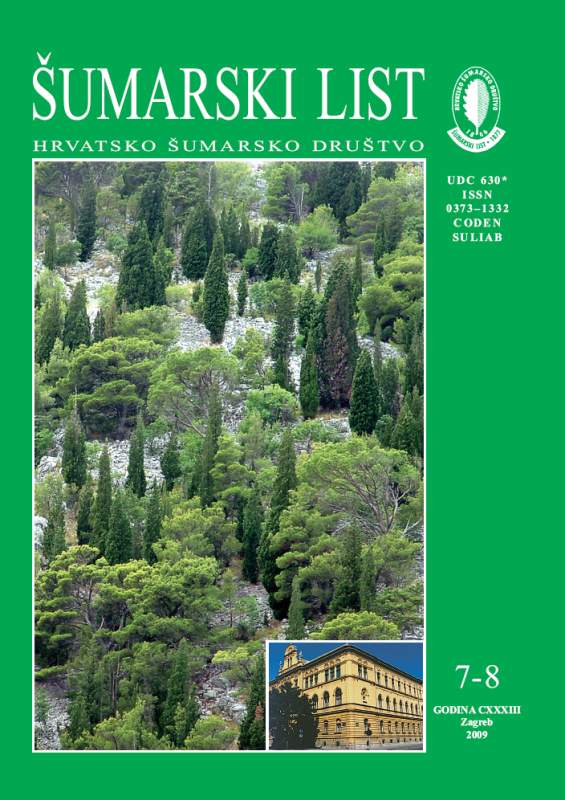
broj: 7-8/2009
pdf (8,4 MB) |
|
||||||||||||||
| RIJEČ GLAVNOGA UREDNIKA | ||
| Branimir Prpić | ||
| MORE ABOUT FORESTS AND NATURE PROTECTIONIN RELATION TO NATURA 2000 IN CROATIA pdf HR EN | 368 | |
| IZVORNI ZNANSTVENI ČLANCI | ||
| Vedriš,M., A.Jazbec, M.Frntić, M.Božić, E.Goršić | UDK 630* 529 (001) | |
| Precision of Structure Elements’ Estimation in a Beech – Fir Stand Depending on Circular Sample Plot Size pdf HR EN | 369 | |
| Matošević,D., M.Pernek, T.Dubravac, B.Barić | UDK 630* 453 (001) | |
| Research of Leafminers onWoody Plants in Croatia pdf HR EN | 381 | |
| Dubravac,T., S.Dekanić | UDK 630* 423 (001) | |
| Structure and Dynamics of the Harvest of Dead and Declining Trees of Pedunculate Oak in the Stands of Spačva Forest from 1996 to 2006 pdf HR EN | 391 | |
| Godina, K. | UDK 630* 569 (001) | |
| Development Structure Elements in Mixed Oak Stands in Aria of ForestAdministration Bjelovar with Retrospect on Modelling Growth andYield of Mixed Stands pdf HR EN | 407 | |
| Cerovečki, Z. | UDK 630* 188 (001) | |
| Beech Forests and Milava –As.Calamagrosti arundinaceae-Fagetum(Ht. 1950) Cerovečki ass. nov. of the Mountain of West Croatia pdf HR EN | 417 | |
| STRUČNI ČLANCI | ||
| Pašičko,R., D.Kajba, J.Domac | UDK 630* 425 (biomasa–Biomass) | |
| Impacts of EmissionTrading Markets on Competitiveness of Forestry Biomass in Croatia pdf HR EN | 425 | |
| Grgurević, D. | UDK 630* 272 (Cactaceae) | |
| Succulents (fat plants) on theAdriatic Coast and their Use in Parks pdf HR EN | 439 | |
| Summary: Succulent plants are gradually colonizing the Croatian coast. These plants initially the collector’s items, but when their ability to tolerate low temperatures was discovered, they began to be grown in the open. Since this species was often mentioned by Croatian Renaissance writers, it can be said with certainty that Opuntia sp. occurred in the Mediterranean and the Adriatic region as early as the 16thcentury, shortly after the discovery of America. Many of the Opuntia sp. and Agave americana plants developed spontaneously by adapting to the new ecological conditions. In fact, the American agave virtually became a symbol of some parts of the Croatian coast. Certain cacti species, such as C. Peruvians „Monstruosus“, which may reach over 4 metres in height, manifest high resistance to cold and are frequently found along the Croatian coast. Due to global warming, some plants, such as Aptenia cordifolia, a species unheard of in these parts only some ten years ago, have acclimatized to the conditions and spread across the coastal area. Apart from these exotic succulents, the Croatian coast is also home to some European fat plants, such as Sedum sp – stonecrop, and Sempervivum sp. –houseleek. Succulents are plants that thrive in stony areas. Still, we should be cautious not to over-plant them, since they impart an exotic appearance. | ||


